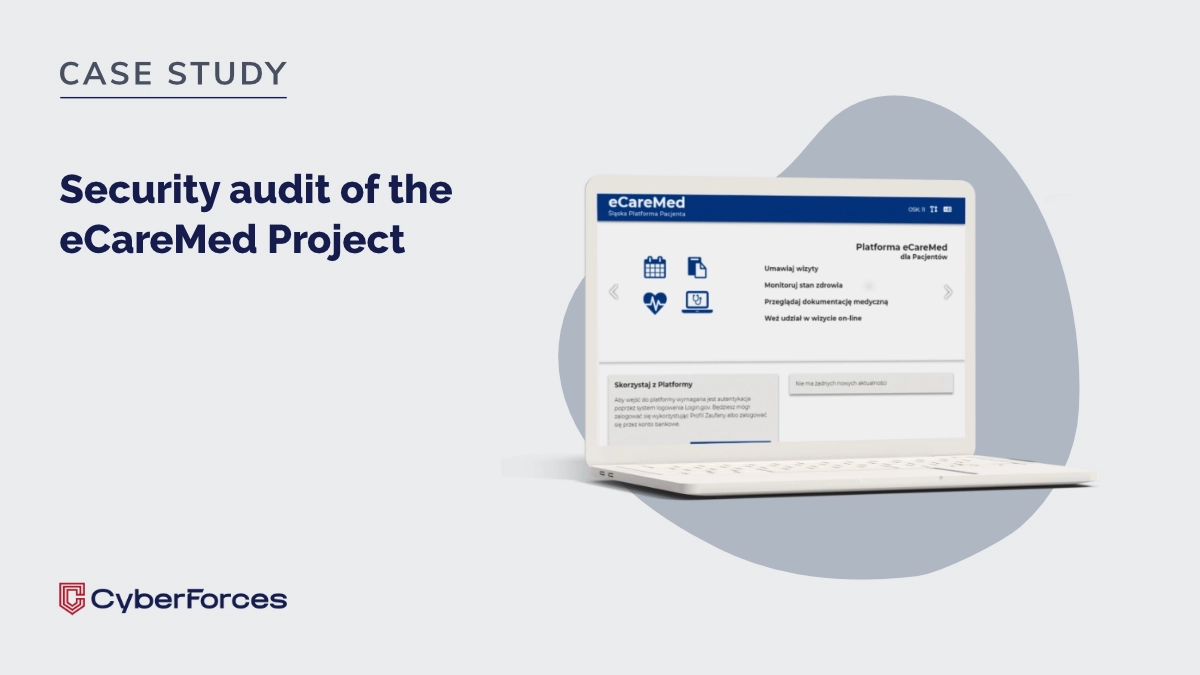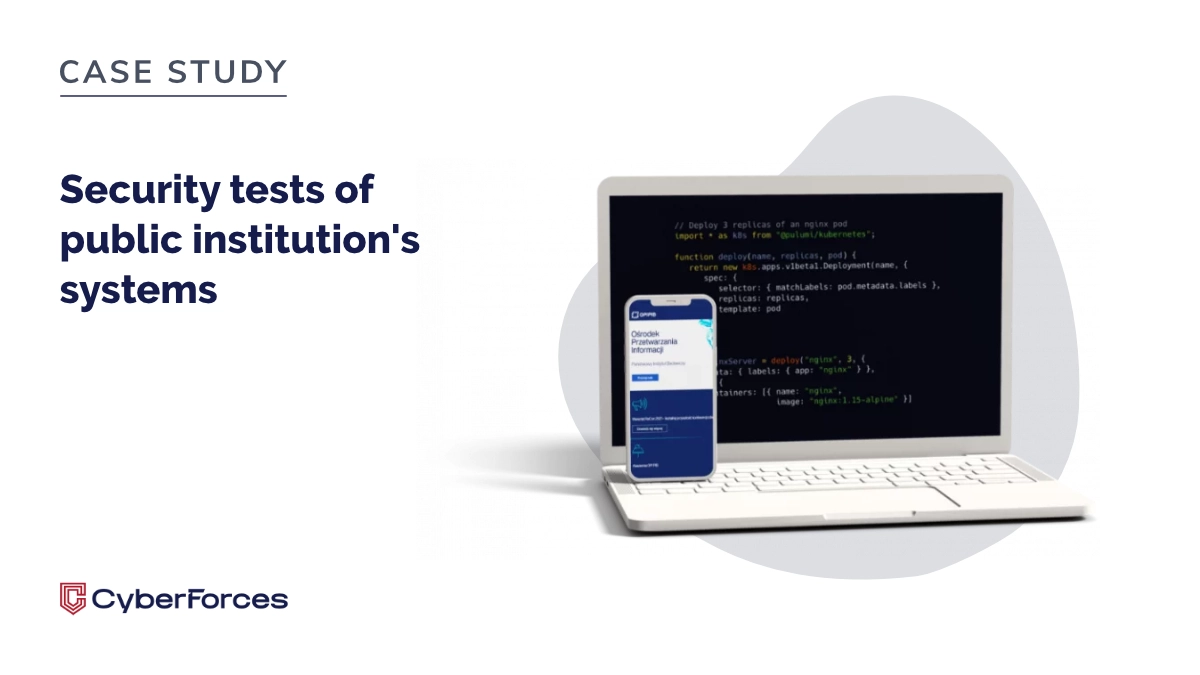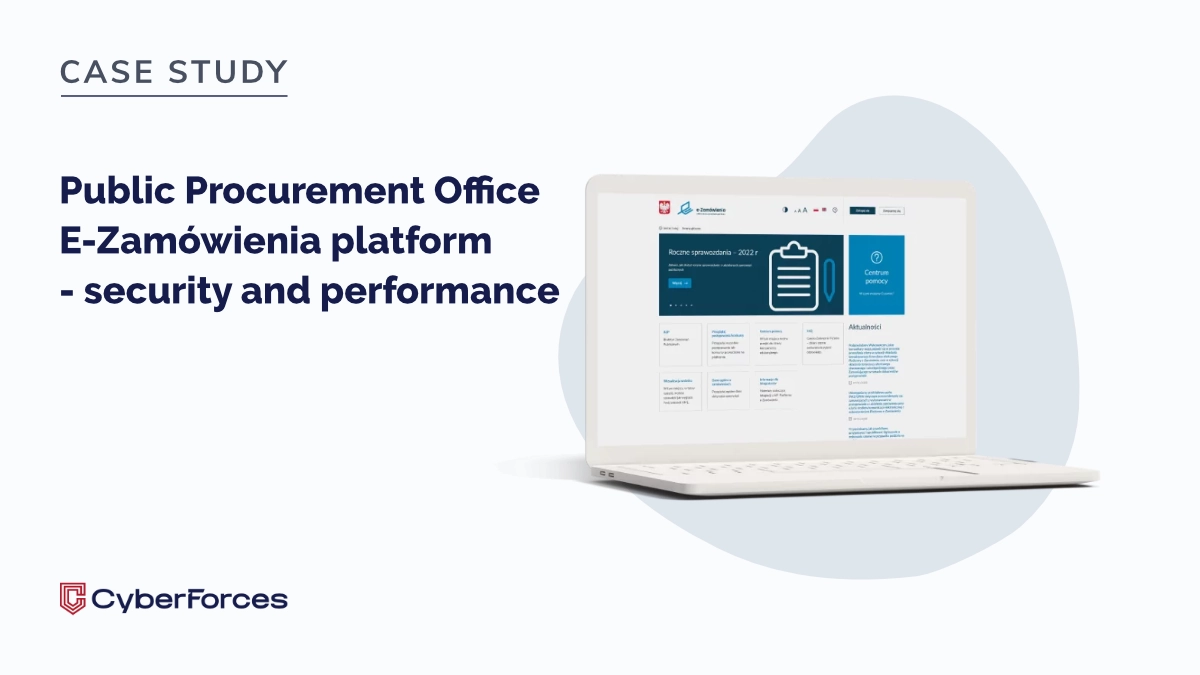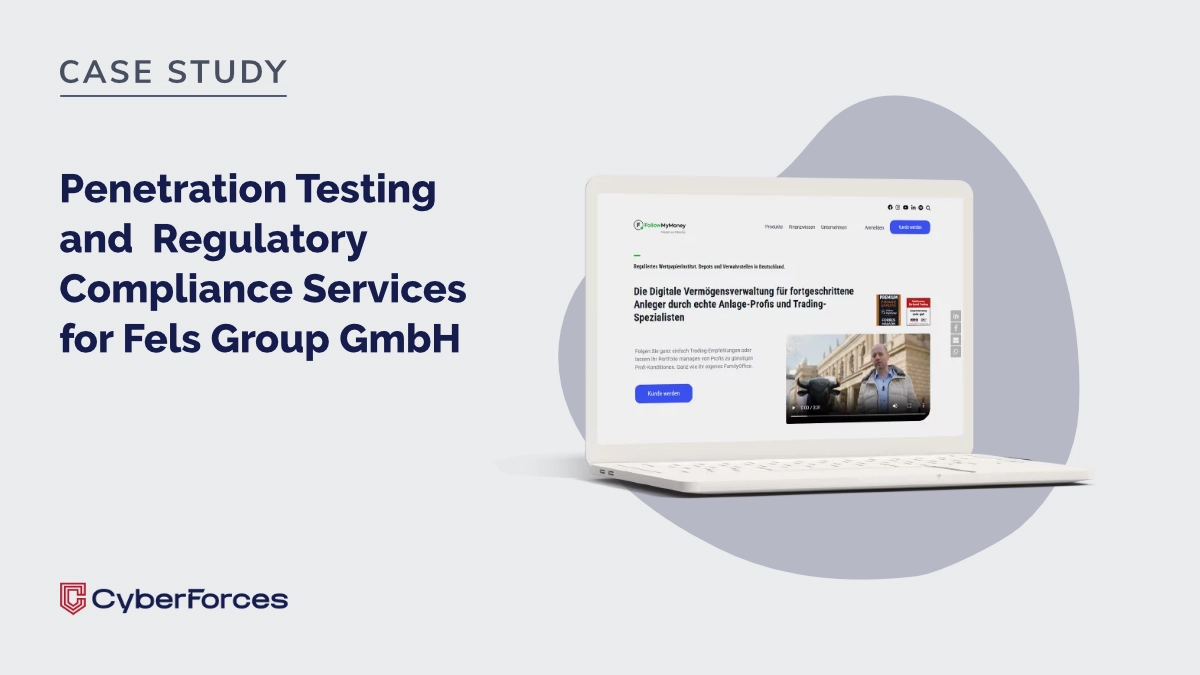Introduction
We carried out a comprehensive audit and penetration tests of the eCareMed platform, a strategic healthcare system incorporating 15 key medical facilities in the Silesian province last year. The system integrates units of varying specialization and status, from provincial hospitals to institutions of national importance, such as the Professor K. Gibiński University Clinical Center and the National Institute of Oncology in Gliwice.
Silesian Digital Medical Platform eCareMed
The primary goal of the implemented system was to increase the accessibility of medical services for patients through the application of modern information and communication technologies (ICT) in the operations of the Medical University of Silesia and 14 collaborating hospitals.
The eCareMed Medical Platform project, with a total value of approximately 78 million PLN, involved the implementation of integrated teleinformatics solutions supporting all medical units engaged in the comprehensive process of diagnosis, treatment, rehabilitation, and patient monitoring outside of medical facilities. A key component of the project was the provision of tools to streamline medical consultations and enable diagnoses based on comprehensive electronic medical documentation. The eCareMed platform delivered numerous functionalities that facilitated the design and implementation of innovative organizational, decision-making, and diagnostic processes based on advanced ICT technologies.
As part of the project, the units covered by eCareMed carry out activities including teleconsultations, telemonitoring, and telerehabilitation. All three components can function both independently and in collaboration, particularly in medical fields such as cardiology, neurology, and oncology.
Audit of the Platform
The key components of the platform subject to the audit included:
- Communication Server Software,
- A unified network layer enabling secure and standardized communication between individual platform components and all its participants.
- The additional components of the platform included:
- Servers with hypervisor software and storage systems responsible for processing the platform’s application layer – the Communication Server Software operates on up to 15 virtual machines based on Linux software.
- Network switches and network connections between the network layer (key component) and the internal networks of individual hospitals within the Ordering Party’s group.
- WAF and Firewall devices owned by the hospitals within the Ordering Party’s group, along with methods for their configuration to connect the internal networks of the hospital group to the key component – the network layer.
- WAF and Firewall devices used to secure and connect the hospitals’ networks, including configuration methods for these devices to establish security policies and VPN connections.
Main Objectives of the Audit
The primary goal of the audit was to identify potential security vulnerabilities in the eCareMed platform and assess the associated risks while developing remediation recommendations. A key aspect of the audit was providing a clear recommendation regarding the system’s readiness for production deployment and availability to end users. The platform comprises many critical components essential for maintaining the continuity of medical operations, including the Communication Server and the advanced network layer.
The overarching objectives of the audit were:
- Identifying vulnerabilities in the eCareMed IT platform, including its key and additional components.
- Assessing risks associated with the identified vulnerabilities in the platform’s key and additional components, and providing recommendations to mitigate these risks to enhance the platform’s resilience against all known forms of cyber threats as of the audit date.
- Due to the service agreements governing the platform and its components, vulnerability impact assessments had to be conducted in line with CVSS version 4.0.
- Analyzing and demonstrating potential unauthorized access to data and resources within the platform, including its key and additional components.
The Ordering Party aimed to verify whether the key and additional components of the eCareMed platform, developed or supplied by contractors, subcontractors, and suppliers, are safe for use and comply with the platform’s design documentation – both the documentation provided during the procurement stage for specific components and the as-built documentation for these components.
The Ordering Party expected a security testing report that would definitively determine whether the regional IT platform is safe for use by system users, project contractors, and administrators.
One of the final deliverables was the auditor’s clear recommendation on whether the eCareMed platform is ready for production deployment (i.e., its availability to end users) or to highlight areas requiring remediation.
Additionally, the audit aimed to identify any potential configuration differences in the platform’s components across different hospitals – so-called deviations or discrepancies from the standards defined by the as-built documentation for the respective components.
Scope of Work:
- Vulnerability and compliance audit:
- We conducted an exhaustive audit using both whitebox and blackbox methods, with an emphasis on manual penetration tests, dictated by the high sensitivity of the processed medical data. Vulnerability scanners were employed as supplementary tools, with tests conducted from three perspectives: from the internet with active security, from the internet with partial security bypass, and from the internal network via VPN.
- Vulnerability assessments were conducted using the CVSS 4.0 scale, with particular attention to the risk of unauthorized data access.
- We carried out compliance audits with the Regulation on National Interoperability Frameworks (NIF), the National Cybersecurity System Act (NCSA), and WCAG 2.1 accessibility guidelines.
- Penetration testing:
- We performed detailed security tests of the network layer, including Web Application Firewall (WAF) devices, Unified Threat Management (UTM) systems, and the SecoManager security controller.
- We audited the management environment based on Kubernetes, Rancher, Galera, and GitHub technologies, verifying the security of management and update processes.
- Special attention was given to tests of authentication and authorization mechanisms, including possibilities for privilege escalation across various system components.
- Functional testing and documentation compliance:
- We conducted a comprehensive verification of platform compliance with project assumptions and the conceptual design of the platform and all its components.
- We identified and documented any discrepancies between the produced platform and the project documentation.
- Particular focus was placed on verifying differences in the configuration of individual system components between hospitals, identifying potential deviations from the defined standard.
- The verification was conducted for all system components required for its proper operation in each of the 15 hospitals.
- Risk analysis and recommendations:
- We prepared a comprehensive Business Impact Analysis (BIA) and Data Protection Impact Assessment (DPIA).
- We developed detailed disaster recovery plans (DRP) for all identified risk scenarios.
- We created recommendations for enhancing security, considering the specifics of the medical environment.
- Collaboration and coordination:
- We maintained regular contact with the client through weekly consultation meetings.
- We implemented a process for immediate reporting of detected vulnerabilities, enabling a rapid response.
- Invasive tests were conducted according to a strictly set schedule to minimize the risk of disruptions in the medical facilities’ operations.
- Final report:
- We provided a detailed report containing full documentation of the tests performed, along with evidence of identified vulnerabilities.
- We prepared detailed corrective recommendations that enable the client to make an informed business decision on where to additionally invest resources to meet the set acceptance criteria, considering the prioritization of actions.
- We presented an analysis of the platform’s execution compliance with the project documentation.
Conclusions
The audit significantly enhanced the security of the eCareMed platform. The project was strategic for the entire region, and its results contributed not only to securing critical infrastructure and medical data but also to verifying the quality of the entire system’s execution. Comprehensive functional tests confirmed the platform’s compliance with project assumptions, ensuring the system meets all required functionalities across all 15 medical facilities. The introduced improvements will elevate the level of security and operational stability, which is crucial for a system serving such a significant number of medical facilities.
Would you like to enhance the security of your system and protect key data? Contact us and find out how our audits and penetration tests can help secure your organization.






